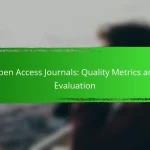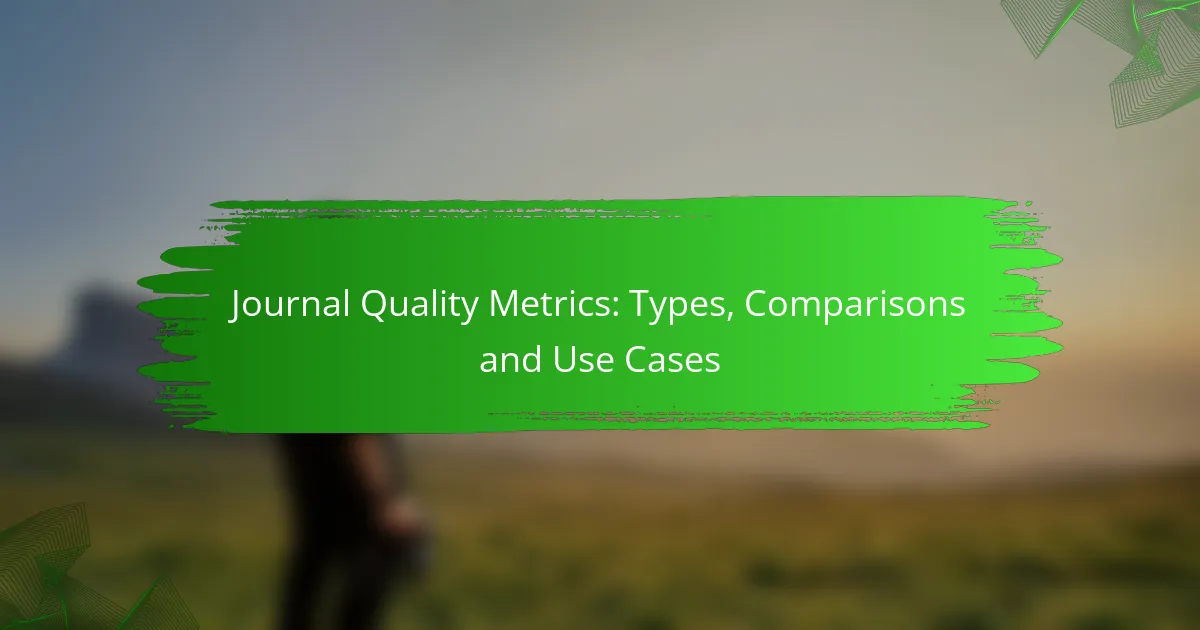Journal quality metrics are essential quantitative tools that evaluate the impact and quality of academic journals, guiding researchers in their publication decisions. With various metrics available, such as Impact Factor and h-index, understanding their differences is crucial for effective evaluation and informed choices in research dissemination. These metrics not only influence publication strategies but also play a significant role in funding decisions and academic career advancement.

What are the key journal quality metrics?
Key journal quality metrics are quantitative measures used to evaluate the impact and quality of academic journals. These metrics help researchers and institutions assess where to publish their work and how to gauge the influence of published research.
Impact Factor
The Impact Factor (IF) measures the average number of citations received by articles published in a journal over a specific period, typically two years. A higher IF indicates a greater influence within the field, making it a popular metric for both authors and institutions.
However, it is important to consider that the IF can vary significantly across disciplines. For instance, journals in the life sciences often have higher IFs than those in the humanities. Therefore, comparing IFs should be done within the same field for meaningful insights.
h-index
The h-index quantifies both the productivity and citation impact of an author or journal. An h-index of ‘n’ means that the author has published ‘n’ papers, each cited at least ‘n’ times. This metric helps in assessing the cumulative impact of a researcher’s work over time.
While the h-index is useful, it has limitations; for example, it does not account for the number of authors on a paper or the context of citations. Researchers should use it alongside other metrics for a comprehensive evaluation.
SCImago Journal Rank
The SCImago Journal Rank (SJR) measures the scientific influence of journals by considering both the number of citations received and the prestige of the citing journals. This metric is based on Scopus data and provides a more nuanced view than the Impact Factor.
SJR is particularly useful for comparing journals across different fields, as it normalizes citation counts based on the subject area. Researchers should consider SJR when looking for reputable journals in their specific disciplines.
Eigenfactor Score
The Eigenfactor Score evaluates the overall influence of a journal based on the number of citations received, adjusted for the quality of the citing journals. This score considers the network of citations, making it a robust measure of a journal’s impact.
Unlike the Impact Factor, the Eigenfactor Score does not count self-citations, which can skew results. This makes it a more reliable metric for assessing the true influence of a journal in the academic community.
Article Influence Score
The Article Influence Score measures the average influence of a journal’s articles over a five-year period. It is derived from the Eigenfactor Score and indicates how often articles in a journal are cited relative to others.
This score is beneficial for authors looking to publish in high-impact journals. A higher Article Influence Score suggests that articles are more likely to be influential in their respective fields, guiding researchers in their publication choices.
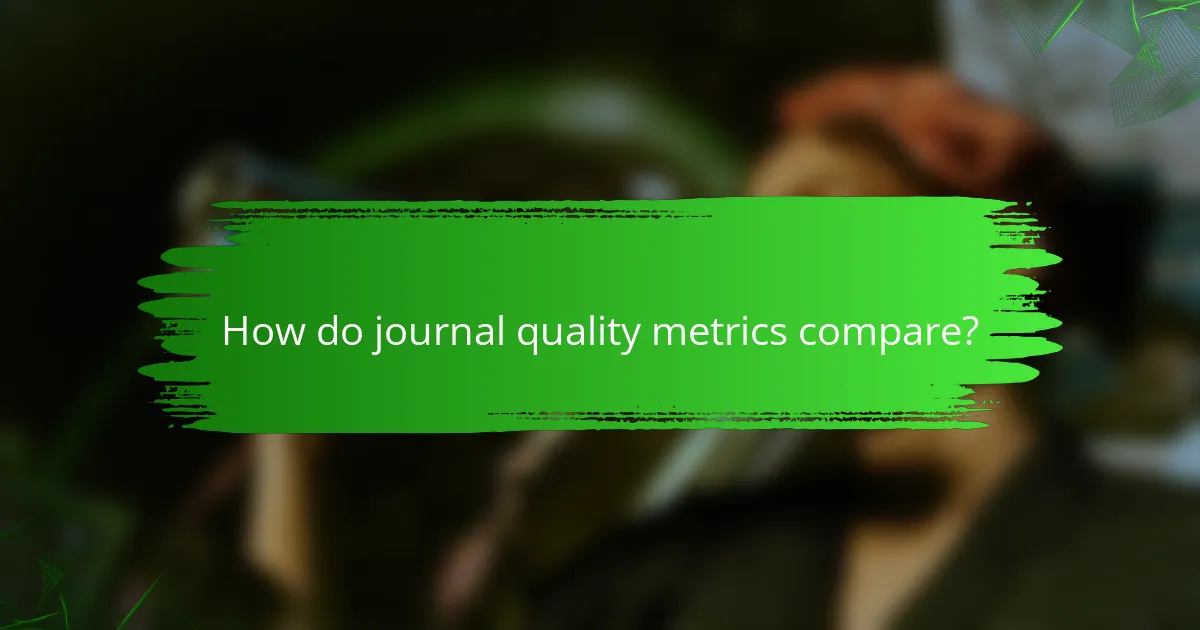
How do journal quality metrics compare?
Journal quality metrics vary significantly in their focus and methodology, making it essential to understand their differences for effective evaluation. Metrics like Impact Factor and h-index serve different purposes, influencing how researchers assess journal quality and relevance.
Impact Factor vs h-index
The Impact Factor measures the average number of citations to articles published in a journal over a specific period, typically two years. It is widely used to gauge a journal’s influence within its field, but it can be skewed by a few highly cited articles.
In contrast, the h-index quantifies both the productivity and citation impact of an individual researcher or journal. A higher h-index indicates a consistent level of citation across multiple publications, providing a more comprehensive view of impact over time.
SCImago vs Eigenfactor
SCImago Journal Rank (SJR) measures journal impact based on citation data, factoring in the prestige of the citing journals. This metric offers a more nuanced view of influence, as it considers the quality of citations rather than just quantity.
Eigenfactor, on the other hand, evaluates the overall influence of a journal by analyzing the number of citations received, adjusted for the source’s importance. It also accounts for citations from non-journal sources, providing a broader perspective on a journal’s impact.
Article Influence vs Impact Factor
Article Influence Score measures the average influence of a journal’s articles over a five-year period, taking into account the number of citations and the prestige of the citing journals. This metric provides a more refined assessment of a journal’s long-term impact compared to the Impact Factor.
While the Impact Factor focuses on short-term citation trends, Article Influence offers insights into sustained scholarly influence. Researchers should consider both metrics to gain a comprehensive understanding of a journal’s standing in the academic community.
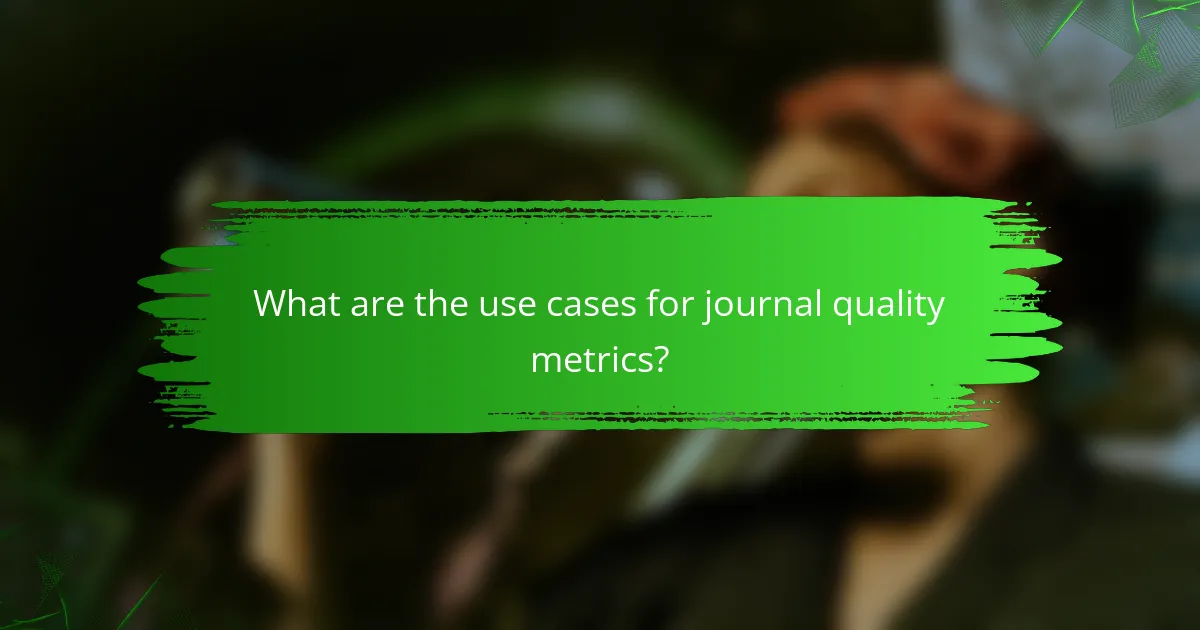
What are the use cases for journal quality metrics?
Journal quality metrics serve various purposes, including guiding research funding decisions, shaping publication strategies, and influencing academic career advancement. These metrics help researchers and institutions evaluate the impact and credibility of journals, ultimately affecting where and how research is disseminated.
Research funding decisions
Funding bodies often use journal quality metrics to assess the potential impact of research proposals. Metrics such as impact factor or h-index can indicate the prestige of the journals in which researchers plan to publish. Higher-quality journals may enhance the perceived value of a project, making it more likely to secure funding.
When applying for grants, researchers should consider aligning their publication plans with journals that have strong metrics relevant to their field. This alignment can improve their chances of receiving financial support, as funders typically prioritize projects that demonstrate a commitment to high-quality dissemination.
Publication strategy
Journal quality metrics play a crucial role in developing an effective publication strategy. Researchers should evaluate metrics like citation rates and journal rankings to identify suitable journals for their work. This evaluation helps ensure that their research reaches the right audience and gains the visibility it deserves.
It’s advisable to balance quality with accessibility; while high-impact journals may offer greater visibility, they often have lower acceptance rates. Researchers should consider their target audience and the specific goals of their research when selecting journals, aiming for a mix of high-quality and more niche publications.
Academic career advancement
Journal quality metrics significantly influence academic career advancement, as many institutions assess faculty performance based on publication records. Publishing in high-quality journals can enhance a researcher’s reputation and increase their chances of promotions, tenure, or securing prestigious positions.
Academics should be strategic in their publication choices, focusing on journals with strong metrics that align with their research area. However, they should also be mindful of the need for a diverse publication portfolio, as a variety of publications can demonstrate a well-rounded research profile. Networking and collaboration can further enhance visibility and opportunities in high-quality journals.

What factors influence journal quality metrics?
Journal quality metrics are influenced by several key factors, including editorial standards, the peer review process, and publication frequency. Understanding these elements can help researchers evaluate the credibility and impact of a journal.
Editorial standards
Editorial standards refer to the guidelines and policies that govern a journal’s content and presentation. High-quality journals typically adhere to strict editorial practices, including clear author guidelines, ethical publishing standards, and transparency in operations.
For example, journals that follow the Committee on Publication Ethics (COPE) guidelines are generally viewed as more reputable. Researchers should look for journals with established editorial boards and a history of rigorous publication practices.
Peer review process
The peer review process is critical in determining a journal’s quality, as it involves the evaluation of submitted manuscripts by experts in the field. A robust peer review system enhances the credibility of published research and ensures that only high-quality studies are disseminated.
Journals that employ double-blind peer review, where both authors and reviewers remain anonymous, often provide a more impartial assessment. Researchers should consider the review timeline and acceptance rates, as longer review periods and lower acceptance rates can indicate a more thorough evaluation process.
Publication frequency
Publication frequency can impact a journal’s visibility and relevance in its field. Journals that publish regularly, whether monthly or quarterly, tend to maintain a steady flow of new research, which can enhance their impact and citation rates.
However, a high publication frequency does not always equate to quality. It is essential to balance frequency with the rigor of the review process. Researchers should assess whether a journal’s publication schedule aligns with their needs for timely dissemination of research findings.

How to select a journal based on quality metrics?
Selecting a journal based on quality metrics involves understanding the specific metrics that reflect the journal’s reputation and relevance to your field. Key considerations include the target audience, the relevance of the metrics used, and how these factors align with your research goals.
Assessing target audience
Identifying the target audience for your research is crucial when selecting a journal. Consider who will benefit from your findings—academics, practitioners, or policymakers—and choose a journal that caters to that demographic. For example, a journal focused on clinical research may be more appropriate for studies aimed at healthcare professionals.
Additionally, examine the journal’s readership statistics and engagement levels. Journals with a higher readership often indicate a broader impact, which can enhance the visibility of your work. Look for journals that publish articles similar to yours to ensure alignment with your audience.
Evaluating metric relevance
Quality metrics can vary significantly in their relevance to different fields. Common metrics include impact factor, h-index, and citation rates, but their significance can differ based on discipline. For instance, in the sciences, impact factors may be more critical, while in the humanities, qualitative assessments might hold more weight.
When evaluating metrics, consider their context and how they reflect the journal’s quality. A journal with a high impact factor may not always be the best choice if it does not align with your research focus. Look for metrics that are recognized in your field and that accurately reflect the journal’s influence and credibility.
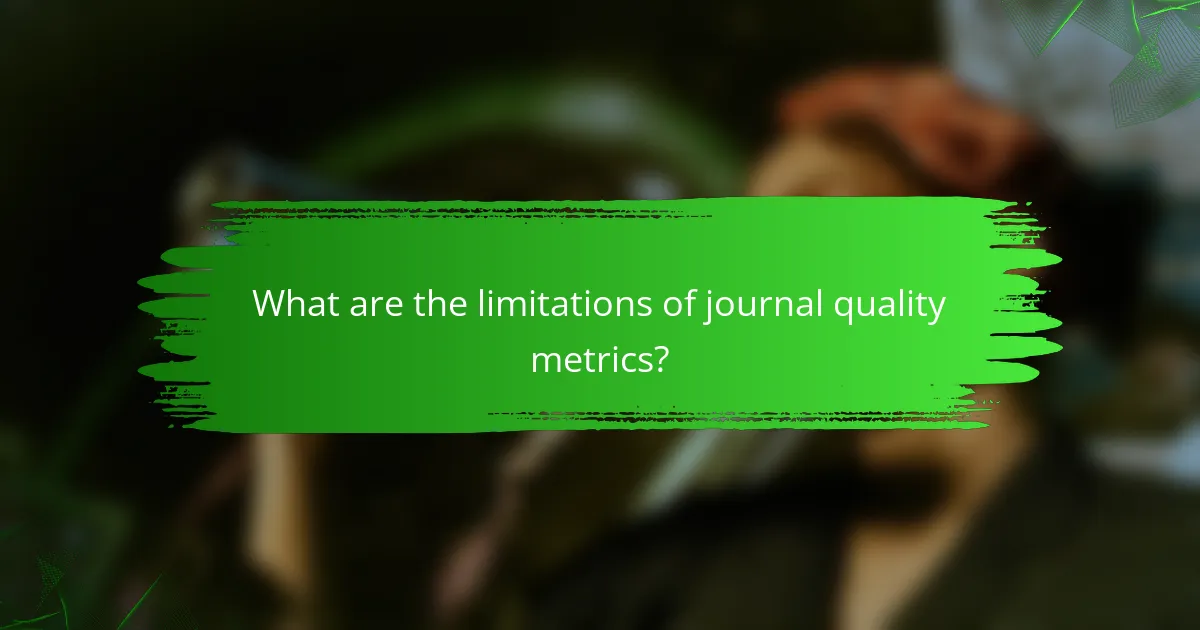
What are the limitations of journal quality metrics?
Journal quality metrics have several limitations that can affect their reliability and usefulness. These metrics may not fully capture the quality of research, as they often focus on quantitative measures rather than qualitative assessments.
Metric manipulation risks
One significant risk associated with journal quality metrics is the potential for manipulation. Authors and journals may engage in practices such as citation stacking, where they artificially inflate citation counts to improve their metrics. This can mislead stakeholders about the true impact and quality of the research.
Additionally, some journals may prioritize metrics over rigorous peer review processes, leading to the publication of lower-quality studies. Researchers should be cautious and critically evaluate the metrics used when assessing journal quality.
Field-specific variations
Journal quality metrics can vary significantly across different academic fields, making comparisons challenging. For instance, citation practices in the humanities differ from those in the sciences, where rapid publication and citation rates are more common. This variation can skew perceptions of quality based on discipline-specific norms.
It’s essential for researchers to consider the context of their field when interpreting journal metrics. Understanding these field-specific variations can help in making more informed decisions about where to publish and how to assess the quality of journals.


